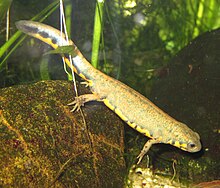Fire-bellied newts
| Fire-bellied newts | ||||||||||||
|---|---|---|---|---|---|---|---|---|---|---|---|---|

Chinese fire-bellied newt |
||||||||||||
| Systematics | ||||||||||||
|
||||||||||||
| Scientific name | ||||||||||||
| Cynops | ||||||||||||
| Tschudi , 1838 |
Fire-bellied newts ( Cynops ) are a genus of tailed amphibians with an East Asian distribution and only seven species, one of which appears to be extinct at the end of the last century. The newts , some of which are kept as aquarium animals , often live endemically in a small area.
features
Cynops species are generally smaller than those of the related genera Pachytriton or Paramesotriton . Their total length is usually 8 cm for males and 10 cm for females. Only the specimens of the swordtail newt and the recently extinct Cynops wolterstorffi are or have become larger.
On the back and on the flanks, the newts are darkly colored, depending on the species from deep black to black olive or dark brown. The underside of the body is bright orange to red with black spots. Stripes and spots the color of the abdomen can also appear on the flanks, legs, head, or tail.
Except for Cynops wolterstorffi , their skin is rough. The tail is flattened laterally. They usually have 13, in rare cases 14, trunk vertebrae .
distribution
Cynops species are only found in southeastern China and Japan , where some of them are endemic.
Systematics
The genus was first described in 1838 by Johann Jakob von Tschudi . It has seven types:
- Sword-tail newt - Cynops ensicauda (Hallowell, 1861)
- Chinese fire-bellied newt - Cynops orientalis (David, 1873)
- Japanese fire-bellied newt - Cynops pyrrhogaster (Boie, 1826)
- Wolterstorff newt - Cynops wolterstorffi (Boulenger, 1905) †
- Cynops chenggongensis Kou & Xing, 1983
- Cynops cyanurus Liu, Hu & Yang, 1962
- Cynops orphicus Risch, 1983
Molecular biological studies indicate that the genus is paraphyletic , but it forms a clearly monophyletic clade of around 15 species with the closely related genera Pachytriton and Paramesotriton .
